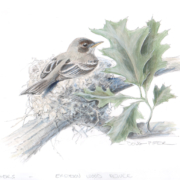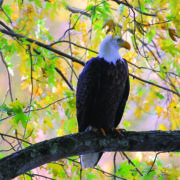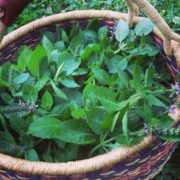Lead is a soft, pliable, elemental metal that is found in naturally occurring deposits around the world. While it has been used for centuries for many purposes, the highly toxic properties of lead have become well-known over the last 100 years through the issues of food contamination in cans sealed with lead solder, the toxic effects of lead-based paints and glazes, the polluting effects of leaded gasoline, the presence of lead in drinking water which passes through pipes connected with lead solder, and, more recently, the toxic effects of lead ingested by wildlife.
In wildlife, lead is most toxic when consumed by an animal, as opposed to lead bullets or shot simply lodging in muscle tissue. Exposure to digestive fluids and stomach acids breaks down the lead, allowing it to be absorbed into the blood stream and distributed to internal organs, the nervous system, the respiratory system, and the renal system. Lead may also leach from lead fragments lodged in joints and in bone marrow.
In 1991, the public became very concerned that nearly four million waterfowl in North America were dying from lead poisoning each year. Ducks and geese were ingesting bits of lead they found while filter feeding on the bottoms of
wetlands, marshes, shallow estuaries, or other bodies of water. The lead fragments the birds ingested were mainly shotgun pellets that had missed their primary target and rained down over the water.
The birds would deliberately pick up this shot and swallow it, thinking it to be food or grit they need for digestion. After years of debate, the federal government finally enacted a ban on the use of lead shot for most waterfowl hunting. The use of lead and lead-based projectiles for hunting of so-called upland species of game and nuisance wildlife has remained legal, presumably on the logic that spent shot which falls upon the land is very unlikely to be found and ingested by wildlife.
However, overwhelming scientific evidence now confirms that lead fired at upland game and nuisance animals is also finding its way into non-target wildlife, but mainly from lead projectiles that actually hit their intended targets. This lead is being ingested by eagles, raptors, scavengers, and non-target species when they prey upon wounded animals that have been shot, or scavenge the remains and entrails of animals that have been shot and left in the field.
While this once unrecognized toxic threat has existed for many decades, there is a dramatically increased awareness of the problem because new technologies and increased surveillance have enabled lead poisoning cases to be more readily identified. Also, the successful recovery and rapid expansion of once-endangered populations of species like Bald Eagles, whose historic habitat is greatly diminished, are forcing the birds to move into sub-optimal habitats where preferred food sources are not readily available.
As they move farther away from major bodies of water, like tidal rivers and bays, and are no longer able to find adequate supplies of fish for their normal diet, birds like Bald Eagles resort to scavenging as a primary foraging practice. Especially during and after the hunting season, animals and animal parts that are left in the field become a main food supply. As a result, often tiny fragments of the lead-based ammunition that remain in these dead animals and animal parts are available to be consumed by Bald Eagles and other
scavengers.
Between 2011 and 2017, the Wildlife Center of Virginia admitted 275 Bald Eagles, with 55 eagles being admitted in 2017 alone. The majority of these eagles came from the eastern third of Virginia, the Tidewater and Piedmont regions. More than two-thirds of the eagles admitted were suffering from measurable lead intoxication, to varying degrees.
Of the 55 birds admitted in 2017, approximately 35 percent had clinically observable indications of lead intoxication, including a general listlessness, inability to maintain balance, refusal to eat, overall weakness, and lack of muscle coordination. In severe cases, lead intoxication can cause a head tilt, blindness, convulsions, and eventually death. In such cases, treatment options are very limited and seldom successful.
Another 35 percent of the eagles admitted in 2017 were found to have elevated but less critical levels of lead in their blood, indicating some degree of intoxication, though the noticeable effects were less obvious. With “sub-clinical” levels of lead in their bloodstream, eagles may appear normal but still suffer damaging effects of the toxicosis. The birds may be able to fly, but with less agility. They may be able to see, but with less precision. They may be able to feed themselves, but not capture live prey. Their reaction time and reflexes may be slowed. Such sub-clinical intoxication is the functional equivalent of driving drunk; the birds are more likely to suffer accidents or injuries that would otherwise be avoidable.
As in waterfowl, the source of the toxin in eagles is lead shot and bullet fragments that were ingested by the birds as they feed. Frequently, diagnostic radiographs of the eagles show actual lead shot or bullet fragments still in a bird’s digestive tract. In some cases, the lead can be surgically removed, but not always. Even if the actual projectile has passed out the digestive tract and no longer remains in the body, dangerous amounts of dissolved lead can still be circulating in the blood or stored in the bones, brain, or internal organs of the body. No level of lead in the body is considered “safe.”
Compounding the threat is that, unlike organic toxins, lead is a heavy metal; an eagle’s internal organs are not able to easily purge the lead in the bird’s bloodstream. Once the lead enters the body, it remains virtually forever, accumulating in the bones of the bird and continuing to have permanent negative impacts. If the bird is exposed to additional lead in its diet, the amount of the toxin will accumulate and increase over time, eventually affecting the bird’s ability to survive. The cumulative impacts can last for years, and can only get worse over time.
For many people who don’t like hunting, this seems like an easy answer; but the truth is, it’s not that easy. Hunting is not as popular as it once was in the United States, as a greater percentage of our population has gravitated to urban and suburban locations, but it is still an extremely popular pastime in the United States. In some states, like Virginia, hunting and fishing are rights guaranteed in the state constitution. And, to some extent, a hunting ban would be like banning driving as a way to reduce traffic accidents—not a proportional response. In truth, many of the leaders of the movement to eliminate lead from hunting ammunition are themselves, hunters. They are often the most effective messengers for information about lead toxicity. Conversely, someone who openly opposes all hunting is NOT the right person to try and educate or inform the hunting public about this issue. It may make you feel good to rant about hunters and declare, “Just shoot the hunters!” but that is actually extremely counterproductive. The issue is about the availability of lead to scavengers, not about whether or not hunting is a good thing.
The challenge is not to find a way to ban the use of all lead — it is to find a way to reduce the amount of toxic lead fragments available to non-target wildlife and to do it without unreasonably affecting those whose activities are otherwise legal and acceptable to the public. Most lead-based firearms ammunition is used for national defense and public safety — by the military and police agencies. Target and competitive shooters, and those who own firearms for self-defense, consume the majority of munitions purchased by the private sector. Hunters use only a small percentage of all ammunition sold in the United States each year. A ban on all lead-based ammo would deal a serious blow to national security and public safety, and would hurt a lot of law-abiding firearms users, who are not contributing to the problem of lead-poisoned wildlife!
Thanks to the Wildlife Center of Virginia for this dispatch. The Wildlife Center of Virginia was formed in 1982 to provide quality health care, often on an emergency basis, to native wildlife. For more information, visit www.wildlifecenter.org








